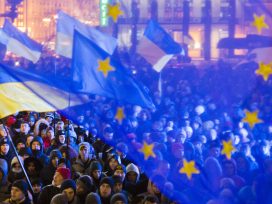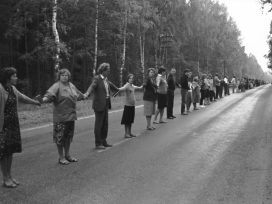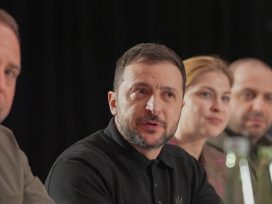Though Russia’s annexation of Crimea in March 2014 moved at breakneck pace, it followed a long anti-Ukrainian propaganda campaign. Katerina Sergatskova describes the growing mutual alienation between the inhabitants of the peninsula and mainland Ukraine.
– What’s the weather like in Kyiv? Is it warm?
– Yes, what about Simferopol? Is it warm too?
– It’s OK at the moment. But they’re predicting frost in Moscow for the weekend…
– What’s Moscow got to do with this?
– I don’t know, it just slipped out…
This conversation I had recently is a good illustration of how the minds of people have been affected by the annexation of Crimea and the events of the ensuing two years. The shift in geographical borders was followed by a change in the perception of reality and a parallel mental shift. In this article I will try to assess how serious that shift has been.
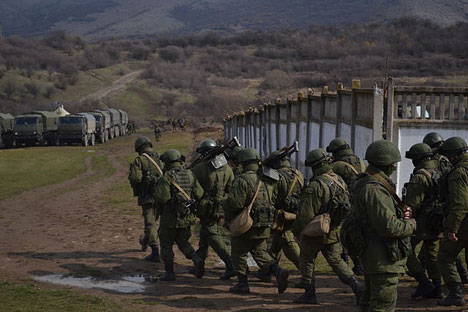
“Little green men” and lorries after the seizure of Perevalne military base, Crimea, 9 March 2014 Photo: Anton Holoborodko. Source: Wikimedia
On 22 February 2014, Russian officers of the 31st Ulyanovsk air assault brigade were awoken by an alarm. Two days later, they reached Sevastopol via Novorossiysk on board a large landing ship “to ensure security during the referendum and to demonstrate the power of the Russian military” (in the words of the military command).1 On 27 February, the building of the Crimean Supreme Soviet was taken over and an armoured military carrier appeared at the gates to Simferopol. From then on, events unfolded at breakneck speed.
Yellow-and-blue flags on administrative buildings were replaced with white-blue-and-red ones; the peninsula switched to Moscow time; military bases were taken over by Russian forces; international trade companies were closed down; the airport ceased to accept international flights, and railway services were stopped. Reprisals against Crimean Tartars began; Russian authorities charged four Ukrainian citizens with terrorism, sentencing them to a total of 44 years; a trade blockade of Crimea imposed by Ukraine developed into an energy blockade, culminating in the Ukrainian Cabinet of Ministers issuing a decree that suspended trade relations with the peninsula. In the course of two years, the Crimean population on the one hand and the Ukrainian population on the other have gone down a long and arduous path of mutual alienation with a large part of this process taking place on a virtual level.
The annexation of Crimea followed a long preparatory propaganda campaign, aimed at the local population whose overwhelming majority was, for historical reasons, Russian speaking. In hindsight it seems obvious that the ground for the conflict had been prepared well ahead of the actual events. Flames of hysteria around the language issue and the alleged “Ukrainianization” had been fanned for many years. In fact, it was the language issue – Verkhovna Rada deputy Vyacheslav Kyrylenko’s demand that the law on regional languages be abolished – that formally triggered the anti-Ukrainian protests in Crimea in late February 2014. The Russian invasion itself and the seizing of the Supreme Soviet of the Autonomous Republic of Crimea were presented as actions “in defence of the Russian-speaking population”. It was at this point that the people, stirred up by the aggressive rhetoric on TV channels transmitting Kremlin propaganda, took to destroying Ukrainian street signs and other signage in Ukrainian. Admittedly, this vandalism was short-lived, and many Ukrainian signs still remain.
A new language law was one of the first pieces of legislation adopted by the occupation authorities in Crimea: the Russian, Ukrainian and Crimean Tatar languages were declared to be equal in status. In reality, however, the teaching of Ukrainian and Crimean Tatar in schools has been reduced and made optional, while public disapproval of the Ukrainian and Crimean Tatar nationality has been sanctioned at the highest political level since speaking Ukrainian has become a political statement. As a result, part of the Crimean population has de facto lost its right to speak up in public. In practice, language censorship has been imposed.
Crimea was annexed without a single shot being fired and this “peaceful” takeover of the country forms the basis of the Kremlin’s policies on the peninsula. As war flared up in Donbass, refugees were being welcomed in Crimea, donations were organized in support of the “Donbass national territorial army” and people volunteering to take part in the fight for a “Russian World” were being trained, that is to say, military action was openly supported. However, what dominated public discussion was the sense that what really mattered was that there had been no war in Crimea and that Russia had “prevented” a disaster by annexing the disputed territory. In essence, Crimeans used the war in Donbass to justify their own treachery in the 16 March referendum. Official propaganda “deleted” from the logical chain of events the link that clearly demonstrates that it was the annexation of Crimea that triggered the military conflict in Donbass and that Crimea itself has become a military base serving it. In this way, the Crimeans were able to deny their responsibility for what has happened.
Incidentally, the question of how far the population of Crimea, addled by Russian propaganda, is responsible for the annexation, remains controversial. Those who took part in the 16 March referendum and later lined up for Russian passports have been mere pawns, used by the Kremlin’s secret services to bring their project to fruition. On the other hand, this project could never have been realized without the necessary public support and even if it had, it wouldn’t have lasted long. As is well-known, power based on violence and lacking real grassroots support breeds tyranny, which is not a viable system. So the fact that there has been no social upheaval in Crimea over the past two years suggests that the majority of the population is either happy with the present state of affairs or, more probably, too passive to take any kind of action.
Soon after the referendum, the small, formerly proactive, part of the Crimean population (Crimean Tatars, Ukrainians and Russians involved in civic activism on the peninsula) who opposed the annexation became the target of open repression. Unfortunately, the extent to which this repression has become part of everyday life can be gauged only from Russian reports and posts on social media, which give a somewhat distorted picture. The fact is that over these two years, practically every independent Ukrainian journalist has been forced to leave Crimea. They were either “squeezed out” by the security services by means of threats of criminal charges, or they chose not to continue working under total censorship and risk their life and health. It is therefore increasingly difficult to find out about crimes taking place there. But even the minimum of information that does trickle out from Crimea to the continent allows us to conclude that repression on the peninsula is well and truly flourishing.
The referendum was the starting point for a shift in the international political situation and in the lives of thousands of private individuals directly affected by the annexation. The annexation itself was followed by sanctions against Russia, a collapse in the value of the rouble, the start of an economic crisis, and growing criticism of Vladimir Putin. At the same time we have seen a massive migration of Crimeans from the peninsula to Ukraine proper, which, in turn, has made many of them realize that they are perceived as aliens and often as “separatists” (many Crimeans, as well as Ukrainians registered as resident in Lugansk and Donetsk, have been refused rental accommodation). Similarly, the financial system did not, and still does not, recognize these people as residents of Ukraine – they cannot open a bank account. Many families have been torn asunder by ideological disagreements as private and public debate has become increasingly emotionally charged.
In the course of the year during which the population of Crimea followed the progress of the war in Donbass and the effects of sanctions, the peninsula stabilized, temporarily dropping off the Ukrainian and global agenda. All that changed when, in autumn 2015, people carrying Crimean Tatar flags appeared on its borders.
***
On 20 September 2015, Lenur Islyamov declared the launch of a “civil trade blockade of Crimea”. Islyamov had served as deputy to Crimea’s leader Sergei Aksyonov from 2 April to 28 May 2014, and is the owner of SimCityTrance, a Crimean coach company, as well as the Crimean Tatar TV Chanel ATR, which was stripped of its broadcasting licence in early 2015 by the Crimean authorities.
The blockade of Crimea was presented as a protest against the lack of response from the Ukrainian authorities to the annexation of the peninsula; against continuing trade relations between Ukrainian companies on the one hand, and Russian and Crimean companies on the other; and against the growing repression of Crimean Tatars and Ukrainian political prisoners. The blockade’s leaders – Mustafa Dzhemilev and Refat Chubarov, in addition to Islyamov – demanded that the Russian authorities release imprisoned Crimean Tatar activists (including the deputy head of the Crimean Tatar People’s Mejlis Akhtem Chiygoz, serving a sentence for “organizing mass disturbances” at a rally on 27 February 2014), and the Ukrainian activists Oleg Sentsov and Nadezhda Savchenko. They also demanded that Ukraine break off trade relations with Crimea, and declared the “de-occupation of Crimea” their main goal.
Two regiments – Right Sector (banned in Russia as an extremist organization) and the Azov Regiment (known for its extreme right-wing views) volunteered to help the organizers by taking on the job of a militia and customs authority and to control the movement of lorries crossing over to the peninsula.
The first days of the blockade were full of hysterics: while some lorry drivers grumbled about losing their wages, others cried that the Crimeans couldn’t be left to starve – “they are our own people after all” – while the armed volunteers tried to teach the drivers and opponents of the blockade “a lesson in patriotism” by pointedly confiscating sausages from Crimeans crossing the border. All of this was, of course, covered by Ukrainian media and from there leaked back to Crimea via Russian propaganda TV channels. The blockade was presented to the Crimeans as a belated illustration of the aggression the population would have experienced, had the peninsula remained part of Ukraine. Thus the picture of “rampaging fascist thugs” materialized, created by Russian propaganda in the late winter of 2014.
Soon after this, the organizers announced that the trade blockade must be followed by an energy blockade. Crimea depends on Ukraine for over 70 per cent of its electricity supplies; three main power stations that supply the peninsula with electricity are situated on the continent close to the border.
On the night of 5 to 6 October, unknown perpetrators blew up a power pylon on one of the power lines used to transmit electricity to Crimea. Right Sector initially claimed they had nothing to do with the incident, describing it as a “provocation” aimed at discrediting the blockade. Incidentally, Islyamov himself made it quite clear on Facebook that he did not regard this kind of action as criminal, and called for electricians to turn off the power at the damaged station “for safety’s sake”. That would have put the energy blockade on a lawful footing. However, when the repair crew arrived at the explosion site, armed Azov Regiment volunteers kept them away from the pylon and prevented them from repairing the power line. Sometime later, unknown perpetrators blew up two substations and the lights in Crimea went out. The reaction to the blackout provides an example of public behaviour in miniature.
The general Ukrainian public response was that of rejoicing, the overall message being that the Crimeans would now finally realize their total dependence on Ukraine, and Russia would soon be forced to give back the annexed territory.
I could hardly keep my emotions under control yesterday. Last night we were live on air at ATR, broadcasting straight from our headquarters. We had prepared answers to anticipated questions on the blockade. But we never expected this explosion of emotion. We could hardly get a word in. We were inundated with phone calls coming in on two parallel lines. Huge numbers of them. There were no questions. Just expressions of gratitude, often with tears. Most of the calls came from Crimea. The main message: “We’re waiting for you. Switch everything off. Come to liberate Crimea, we will help you from here!”
Thus a post on Facebook by Liza Bogutskaya, an émigré from Crimea. It is quite symptomatic that nearly four thousand people “liked” her post and over a thousand shared it. It’s as if this was exactly what the Ukrainian public had been waiting for these past eighteen months – for the Crimeans to be disconnected from the continent’s supplies; and for those among them who had supported the referendum to “repent” and beg to be allowed to join Ukraine again, while those who had been in a minority would be able to step out from the shadows and start “rocking the boat”. People were only too happy to accept Bogutskaya’s myth as reality.
In fact, reality has turned out to be quite different. Those Crimeans who had initially opposed the annexation perceived the blockade as a sign of a lack of understanding on the part of Ukraine and a fresh attempt to further exacerbate living conditions in an area that had already been deprived of railway services, Ukrainian mobile networks and other forms of communication. This became even more pronounced once the power cuts resulted in deaths in hospital operating theatres, while the Ukrainian authorities and opinion makers either failed to respond or responded without the requisite sympathy. This made the people feel that Ukraine had abandoned Crimea and the Crimeans for good. Naturally, this raises the question: even if Crimea were to be returned to Ukraine, could the Crimeans still return there mentally?
At the same time, those Crimeans who support the occupation regime have made it clear that they are willing to brave both a trade blockade and power cuts in order to remain part of Russia. “It’s romantic!” the Crimeans rejoiced. “Now that we have no power we’ve been spending more time walking the streets, meeting friends, enjoying candle-lit dinners…” This mood was confirmed by a VCIOM (Russian Public Opinion Research Centre) opinion poll initiated by Putin on 31 December. The region’s inhabitants had to answer two questions: “Do you support the signing of a commercial agreement with Ukraine to provide Crimea and Sevastopol with some of its electricity supplies, if the deal stipulates that Crimea and Sevastopol are a part of Ukraine?” and “Are you prepared to face some temporary difficulties arising from insignificant disruptions in power supplies over the next 3-4 months?” According to the VCIOM data, 93.1 per cent of Crimeans said they would disapprove of a contract with Ukraine to supply electric power to Crimea and Sevastopol if it stipulated that they be a part of Ukraine.
The repression of Crimean Tatars and pro-Ukrainian activists has also intensified as a result of the blockade: for example, on 2 November 2015, the FSB searched the house of former ATR channel editor Liliya Budzhurova. On 13 January, the so-called Crimean State Soviet passed a resolution that declared the peninsula’s energy blockade by Ukraine an act of genocide. “The blockade of the Republic of Crimea led by the Ukraine Verkhovna Rada deputies Mustafa Dzhemilev, Refat Chubarov and a group of individuals who operate de facto under the control of Ukrainian authorities and are led by Lenur Islyamov, has continued for over four months. This is reflected in daily reports from the Special OSCE Monitoring Mission in Ukraine and represents a clear example of a blatant violation of human rights, hate crime and genocide, inflicting damage on the civilian population of Crimea”, according to the document. Criminal proceedings have been launched against the initiators of the blockade.
***
In effect, the blockade has united the pro-Russian and pro-Ukrainian Crimeans in their shared misery, reinforcing their insular identity. At the same time, it has raised a question about the future of Crimea, apparently for the first time in the entire history of Ukraine’s independence.
What kind of place ought Crimea to become should Russia give up the annexed territory? Should it be a republic with expanded autonomy? An independent country supervised by other governments and international missions? A national republic? A street sign erected on Islyamov’ s orders at the border with the peninsula that has provoked a particularly strong response says: “Crimean Tatar autonomy.” The blockade organizers let it be known that once Crimea has rejoined Ukraine, it ought to be granted a Crimean Tatar autonomous status since the peninsula is the historic homeland of the Crimean Tatars who are basically going through a repeat deportation. This idea unleashed a new wave of hysteria, with some people violently opposed to this kind of autonomy, others heartily embracing it.
We have yet to find a consolidated answer to the sacred question of “who does Crimea belong to?” One thing is for sure: it will no longer fit into the old mental and cultural framework from two years ago. Now we have to figure out how different the framework has become and how quickly Ukrainian society can bring about a new Crimea – a Crimea of dreams, a Crimea of the future, a Crimea that will mark the end of the era of criminal wars and ultimate collapse of the Soviet frame of mind. Unfortunately, this is probably a question that will take some decades to resolve.
The referendum on the status of Crimea was held on 16 March 2014. As we know today, the Russian military was already aware in February 2014 of the plans to conduct a referendum. Cf. the report "Putin: The war", based on an independent investigation by Boris Nemtsov and his team, http://www.putin-itogi.ru/putin-voina/ and interviews with Russian military, sockraina.com/news/15571).
Published 22 February 2016
Original in Russian
Translated by
Julia Sherwood
First published by Eurozine
Contributed by Transit © Ekaterina Sergatskova / IWM / Eurozine
PDF/PRINTPublished in
In collaboration with
In focal points
Newsletter
Subscribe to know what’s worth thinking about.
Related Articles
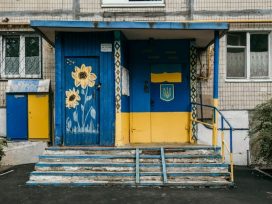
Ukraine faces its greatest diplomatic challenge yet, as the Trump administration succumbs to disinformation and blames them for the Russian aggression. How can they navigate the storm?

Mineral rush
Topical: Critical raw materials
Why does peace in Ukraine hang on a ‘mineral deal’ whose handling is more reminiscent of trade than negotiations? Perhaps because the global race for critical raw material mining is well and truly underway, digging for today’s equivalent of gold: raw earth elements and lithium critical for renewables and digital technology but also modern weaponry.

